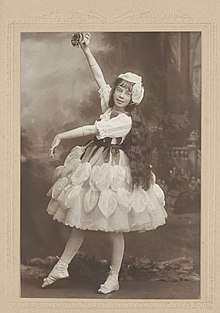Sybil Craig
Sybil Mary Frances Craig (1901–1989), was an Australian painter. She was appointed by the Australian War Memorial to accept the appointment as an official war artist. She was the first woman to paint women working in the munitions’ factories.[1]

Sybil Mary Frances Craig | |
|---|---|
 | |
| Born | 18 November 1901 London, United Kingdom |
| Died | 9 September 1989 (aged 87) Melbourne, Victoria, Australia |
| Nationality | Australian |
| Education | National Gallery of Victoria Art School, Working Men's College |
| Known for | Painting |
Early life
Craig was born in London, England on 18 November 1901.[2] She was the only child of affluent parents Matthew Frances Craig and Winifred Frances, née Major.[3] Her family emigrated to Australia in 1902.[4] The Craigs first lived in Brighton, but moved to Caulfield in 1914 into a house built by Matthew.[5] Craig recalled a childhood spent in a 'suburban bohemian household' that was frequented by artists and musicians.[6]
Career
From 1924 though 1931 Craig studied at the National Gallery of Victoria Art School where she was taught by Bernard Hall, William McInnes and Charles Wheeler.[2] She also studied at the Working Men's College, Melbourne (now RMIT) in 1935.[1] In 1932 she had her first solo show at the Melbourne Athenaeum.[1] She had a studio on Collins Street from 1936 to 1951 and had the financial means that left her free to pursue painting.[2]
In March 1945 Craig became an official war artist, commissioned by the Australian War Memorial Board to record the contribution of women to the war effort. She recorded women working at the Commonwealth Explosives Factory at Maribyrnong, a suburb of Melbourne.[2][7]

Craig was a member of several artistic organizations including the New Melbourne Art Club, the Melbourne Society of Women Painters and Sculptors, the Victorian Artists Society, and the Twenty Melbourne Painters.[2]
In 1978 the Important Woman Artists Gallery in East Malvern held a retrospective of her work.[2]
Craig died 15 September 1989 in Melbourne.[8]
References
- Wilkins, Lola. "Sybil Mary Frances Craig". Design & Art Australia Online (DAAO). Retrieved 27 March 2018.
- Reilly, Dianne. "Craig, Sybil Mary Frances (1901–1989)". Australian Dictionary of Biography. National Centre of Biography, Australian National University. Retrieved 27 March 2018.
- Reilly, Dianne, "Craig, Sybil Mary Frances (1901–1989)", Australian Dictionary of Biography, National Centre of Biography, Australian National University, retrieved 3 June 2020
- "Sybil Craig". National Gallery of Victoria. Retrieved 27 March 2018.
- Reilly, Dianne, "Craig, Sybil Mary Frances (1901–1989)", Australian Dictionary of Biography, National Centre of Biography, Australian National University, retrieved 3 June 2020
- Reilly, Dianne, "Craig, Sybil Mary Frances (1901–1989)", Australian Dictionary of Biography, National Centre of Biography, Australian National University, retrieved 3 June 2020
- Catherine Speck (2014). Beyond the Battlefield, Women Artists of Two World Wars. Reaktion Books. ISBN 978 178023 374 1.
- "Sybil Craig". The Australian War Memorial. Retrieved 27 March 2018.
Further reading
| Wikimedia Commons has media related to Sybil Craig. |
- Sybil Craig: a life in pictures by Olga Tsara